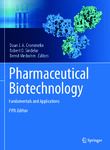| dc.description.abstract | Over the past 30 years, the share of biotechnologically derived drug products in the
arsenal of medicinal products has been growing steadily. These drug products
include proteins, such as monoclonal antibodies, antibody fragments, endogenous
or modified hormones, and growth factors, as well as antisense oligonucleotides,
RNA, DNA preparations for gene therapy, and stem cell therapies. In 2017, 12 out of
the 46 approved marketing authorizations for new molecular entities by the US Food
and Drug Administration (FDA) were biotech products, mainly from the monoclonal
antibody family (Mullard 2018). Drug products such as epoetin-α (Epogen®, Eprex®,
Procrit®), interferon-α (Intron®A, Roferon®A) and interferon-β (Avonex®, Rebif®,
Betaseron®), anti-TNF-α agents, etanercept (Enbrel®), infliximab (Remicade®), adalimumab
(Humira®), bevacizumab (Avastin®), and trastuzumab (Herceptin®) are all
examples of highly successful biotech drugs that have revolutionized the pharmacotherapy
of previously unmet medical needs. And, last but not least, biotech drugs
also have a major socioeconomic impact. In 2017, 7 of the 10 top selling drugs in the
world were biotechnologically derived drug products, with sales varying between
5–16 billion US dollars, totaling 75 billion dollars. The revenues of biotechnology-based
medication are annually growing at a 10% pace and will reach 300 billion US
dollars in 2021, i.e., one third of the total global revenues for brand medicines in that
year (IFPIA 2017).
The techniques of biotechnology are a driving force of modern drug discovery
as well. Due to the rapid growth in the importance of biopharmaceuticals and the
techniques of biotechnologies to modern medicine and the life sciences, the field of
pharmaceutical biotechnology has become an increasingly important component in
the education of today’s and tomorrow’s pharmacists and pharmaceutical scientists.
We believe that there is a critical need for an introductory textbook on Pharmaceutical
Biotechnology that provides well-integrated, detailed coverage of both the relevant
science and clinical application of pharmaceuticals derived by biotechnology.
Previous editions of the textbook Pharmaceutical Biotechnology: Fundamentals and
Applications have provided a well-balanced framework for education in various
aspects of pharmaceutical biotechnology, including production, dosage forms, administration,
economic and regulatory aspects, and therapeutic applications. Rapid
growth and advances in the field of pharmaceutical biotechnology, however, made it
necessary to revise this textbook in order to provide up-to-
date
information and introduce
readers to the cutting-edge knowledge and technology of this field.
This fifth edition of the textbook Pharmaceutical Biotechnology: Fundamentals and
Applications builds on the successful concept used in the preceding editions and further
expands its availability as electronic versions of the full book as well as individual
chapters are readily available and downloadable through online platforms. | en_US |

